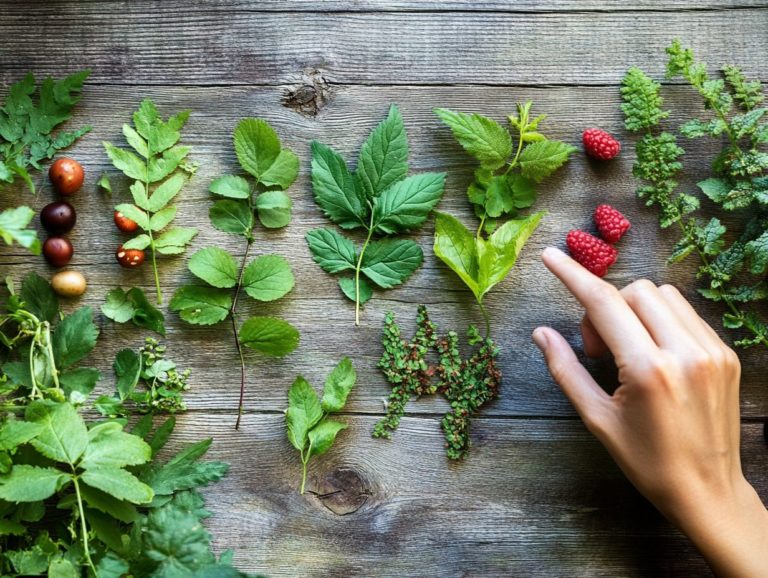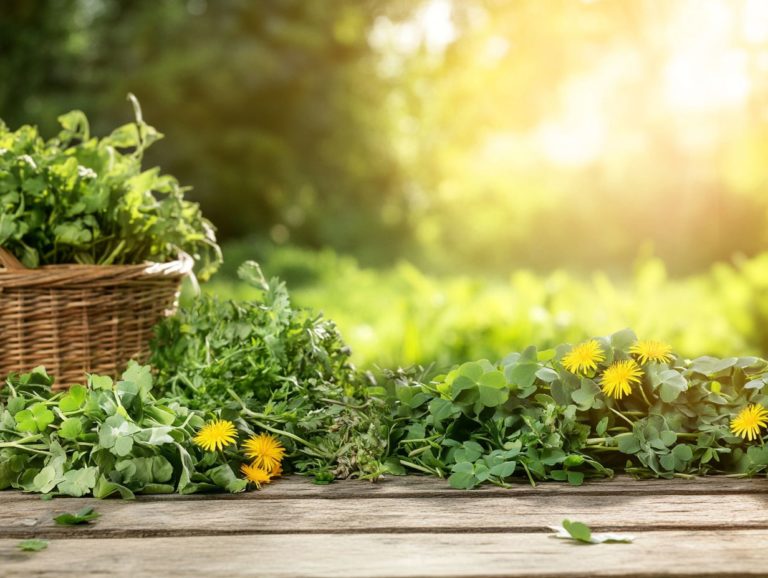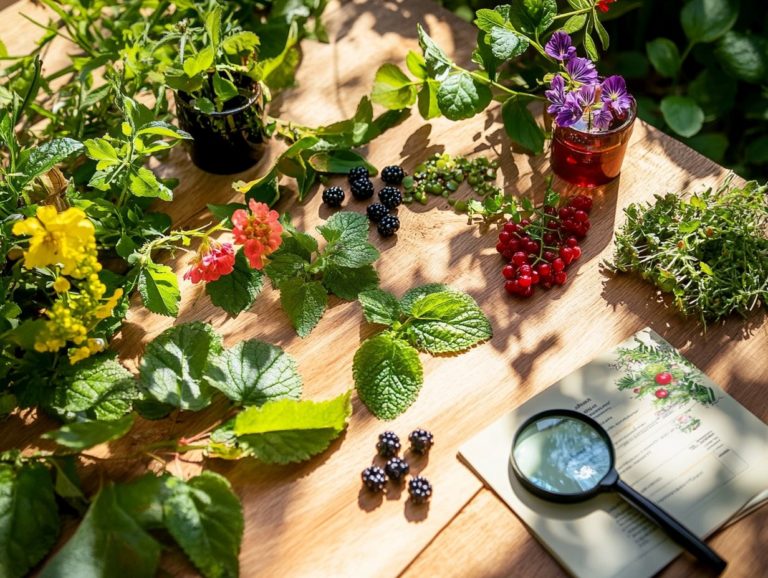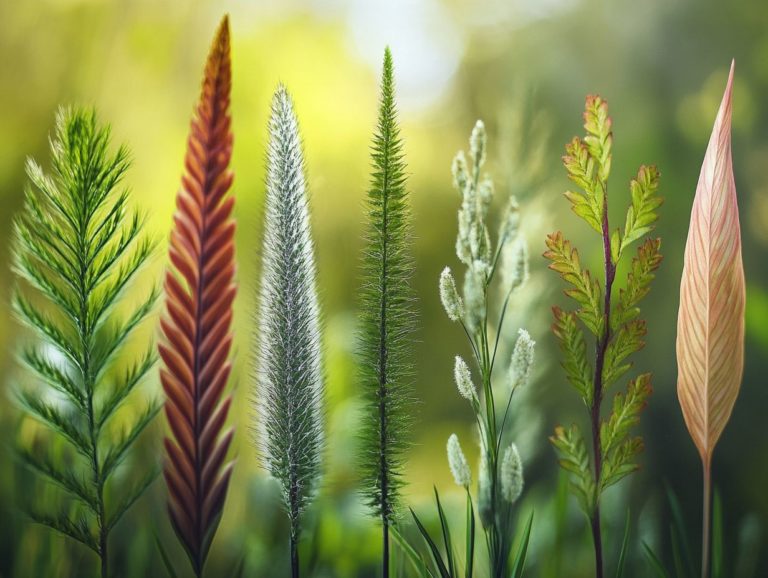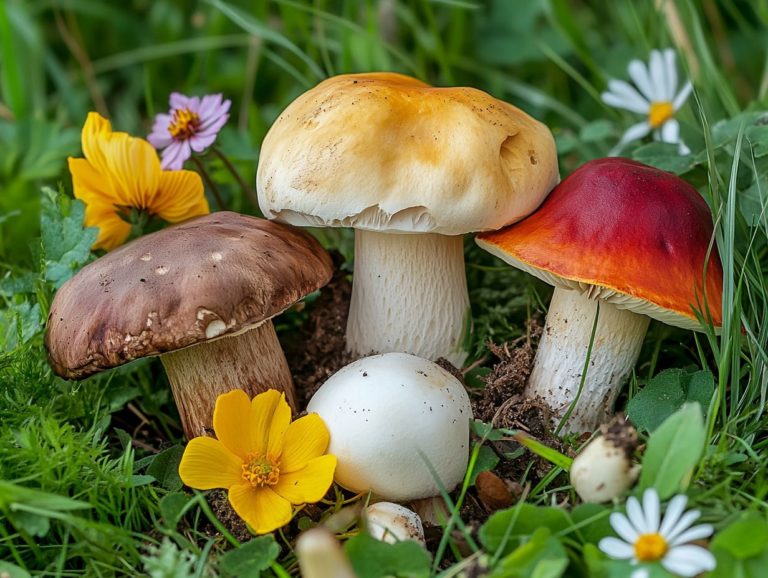5 Edible Wild Greens to Look For
Exploring the great outdoors can uncover delightful culinary treasures right beneath your feet, especially when foraging for food.
Edible wild greens, often referred to as wild edibles, present unique flavors and an abundance of health benefits waiting to be discovered.
Let s shine a light on five remarkable greens dandelion leaves, purslane, nettles, chickweed, and lambsquarters each packed with nutritional goodness.
You ll learn how to identify and harvest these natural wonders and prepare them in mouthwatering ways, including wild salad recipes. You ll also receive essential tips for safe foraging.
We ll tackle common misconceptions and showcase the positive impact these greens can have on the environment.
Get ready to dive into nature s bounty and discover amazing flavors!
Contents
- Key Takeaways:
- 1. Dandelion Greens
- 2. Purslane
- 3. Nettles
- 4. Chickweed
- 5. Lambsquarters
- How to Identify and Harvest Edible Wild Greens?
- What Are the Health Benefits of Eating Edible Wild Greens?
- How Can Edible Wild Greens Be Prepared and Cooked?
- What Are the Precautions to Take When Foraging for Edible Wild Greens?
- What Are Some Common Misconceptions About Edible Wild Greens?
- How Can Incorporating Edible Wild Greens Benefit the Environment?
- Frequently Asked Questions
Key Takeaways:
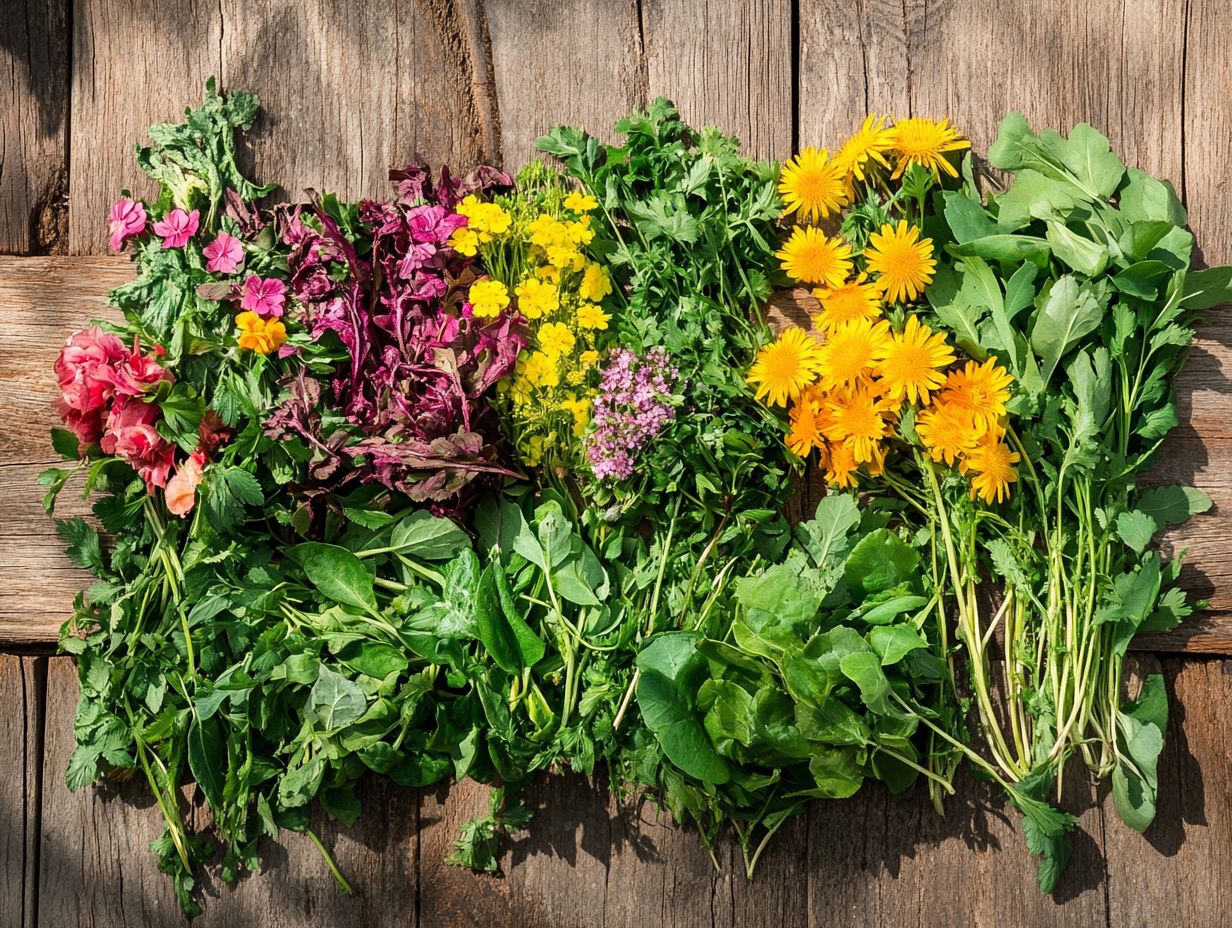
- Dandelion greens are nutritious. Recognize their jagged leaves and yellow flowers. Add them to salads for a tasty crunch or saut them for a delicious side dish.
- Purslane is high in omega-3 fatty acids. Look for its thick, succulent leaves and pink stems. Enjoy it raw in salads, cooked in stir-fries, or blended into smoothies.
- Nettles are rich in vitamins and minerals. They have a distinct stinging sensation when touched. Use them in pesto, soups, or teas after blanching to remove the stingers.
1. Dandelion Greens
Dandelion greens, scientifically known as Taraxacum officinalis, are not just trendy wild edibles; they re a true powerhouse of nutritional benefits. This makes them a staple in the world of foraged foods and herbal remedies.
These vibrant leaves turn a simple wild salad into a culinary delight or can be ingeniously incorporated into homemade pizza and savory spinach dishes.
Loaded with vitamins A, C, and K, along with essential minerals like calcium and potassium, these greens support your overall health in multiple ways. They re also rich in antioxidants, which may help reduce inflammation and promote liver health.
As a culinary enthusiast, you might enjoy using dandelion greens raw, tossing them into wild salads for a delightfully bitter yet refreshing kick. Saut them with garlic for a quick and flavorful side dish.
In herbal medicine, these greens may help with digestion and can act as natural diuretics. When harvesting, be sure to recognize the distinct jagged leaves and bright yellow flowers. Collect them from pesticide-free areas to ensure you re reaping all the sustainability and health benefits they offer.
2. Purslane
Purslane, scientifically known as Portulaca oleracea, is a nutrient-dense wild food. It brings a remarkable zing to your palate with its unique flavor and succulent texture, making it a splendid addition to an array of dishes and wild salads.
Packed with omega-3 fatty acids, vitamins A, C, and E, along with essential minerals like magnesium and potassium, this extraordinary green offers impressive health benefits.
Its culinary versatility allows you to enjoy it raw in salads, saut ed as a side dish, or even blended into smoothies for a delightful nutrient boost.
If you’re feeling adventurous, create infused vinegars by steeping Purslane in vinegar, adding a tangy twist to your dressings and marinades. When foraging, identify the plant accurately, ideally in well-draining soil or garden plots.
Cultivating it at home can also yield a bountiful harvest, granting you easy access to this remarkable superfood.
Start your foraging adventure today and transform your meals!
3. Nettles
Nettles, or Urtica dioica, might just be the wild food you ve been overlooking. They pack a punch when it comes to health benefits. Adding them to your forager’s pantry could be a game-changer. When prepared correctly, you can whip up delightful wild salads or brew them into soothing herbal teas.
These vibrant greens are rich in vitamins A, C, and K, along with essential minerals like iron and calcium. They can bolster your immune system and enhance your overall well-being. Culinary enthusiasts elevate their dishes by using nettles in soups, pestos, and even smoothies. Don’t miss out on this delicious opportunity!
But let s not forget the importance of foraging precautions. Properly identifying nettles is crucial to avoid mixing them up with similar plants. Wear gloves while handling them to steer clear of urticaria, a skin rash caused by the plant’s tiny stinging hairs.
Once you cook or dry nettles, they lose their sting and transform into a delightful addition to wild salads or herbal remedies. They support everything from digestion to inflammation relief.
4. Chickweed
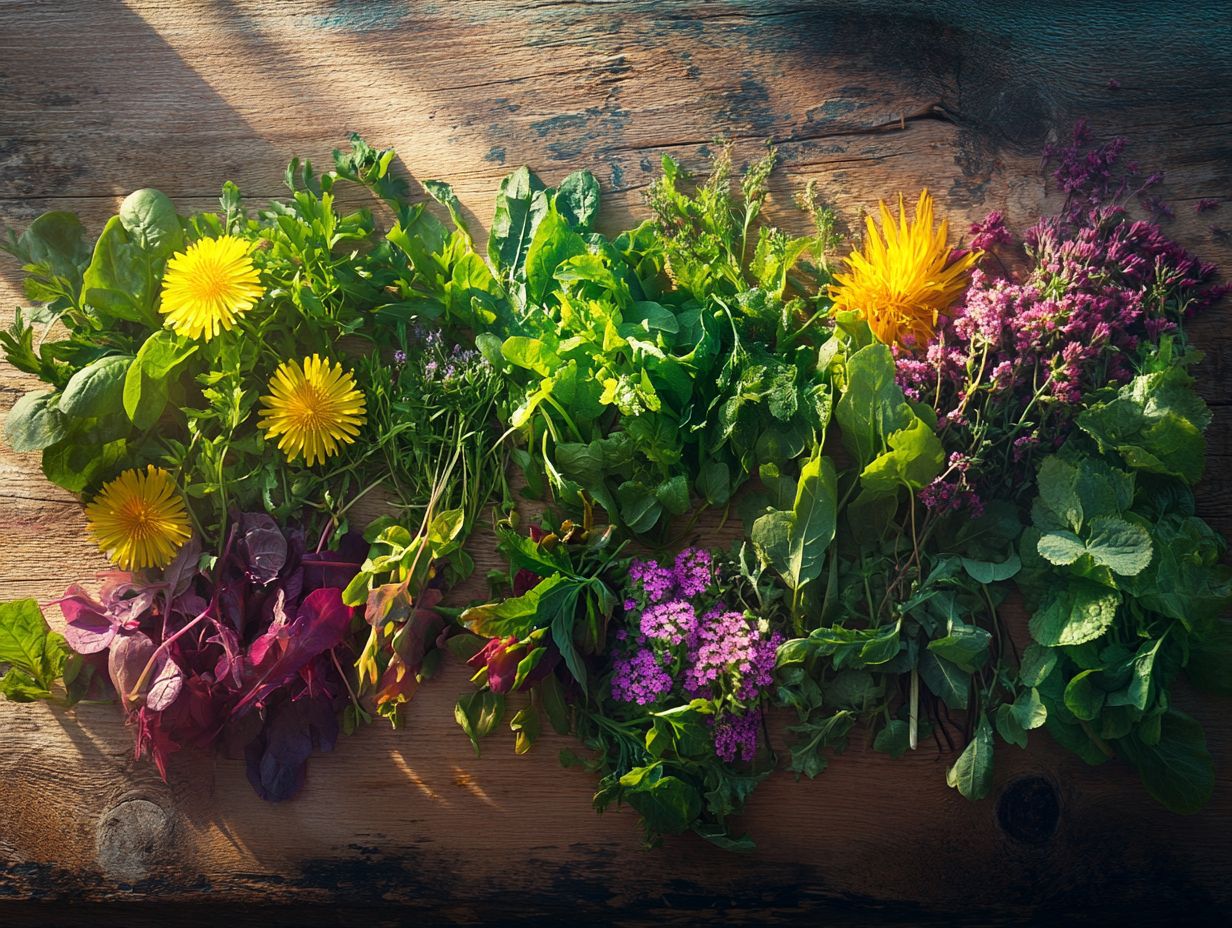
Chickweed, scientifically known as Stellaria media, is a tender and nutritious wild edible. It flourishes in various environments, making it a prime candidate for your foraging adventures. Rich in vitamins and minerals, it seamlessly integrates into wild salads or can be enjoyed as a herbal remedy.
This versatile plant contains vitamin C, magnesium, and potassium, along with antioxidants that support overall well-being. You can add it fresh to soups, blend it into smoothies, or use it as a garnish for various dishes, enhancing them with its mild, pleasant flavor.
In herbal medicine, chickweed has a long history of soothing skin irritations and promoting digestive health. When identifying chickweed, look for its small, star-like flowers and pointed leaves. Aim to harvest it from pristine areas free of pesticides.
To ensure your safety, consult a foraging guide or expert, such as those found in Peterson Field Guides, before incorporating this delightful green into your culinary repertoire.
5. Lambsquarters
Lambsquarters, scientifically known as Chenopodium album, are a gem of the wild food world. They often pop up in gardens and fields, making them an ideal find for you if you’re on the hunt for wild edibles.
Bursting with vitamins and minerals, these greens can elevate your wild salads or make a savory addition to homemade pizza. Packed with essential nutrients like calcium, iron, and vitamins A and C, lambsquarters offer a delightful, mild flavor that enhances a variety of dishes.
When you venture into the wild, accurately identify them by their distinctive triangular leaves and grayish-green hue. For a delightful foraging experience, consider the 5 essential plants to forage in spring and opt for the younger leaves for that tender texture, avoiding any plants like Garlic Mustard that show signs of wilting or disease.
But don t limit yourself to salads; lambsquarters can be saut ed, tossed into soups, or blended into pestos, proving to be a versatile ingredient for any forager s kitchen. Start foraging today and explore these incredible wild greens!
How to Identify and Harvest Edible Wild Greens?
Identifying and harvesting edible wild greens demands not just a sharp eye but also a solid grasp of plant characteristics. Additionally, it requires a deep respect for the environment and sustainable practices. This approach makes your foraging experience both rewarding and safe. Familiarizing yourself with key species like Plantago and Viola spp. is essential for successful foraging, especially in areas such as Toronto, where you can discover 5 wild edible ingredients for comfort food.
Understanding the specific visual traits of these plants like leaf shape, coloration, and growth patterns is crucial for distinguishing safe greens from potentially harmful look-alikes. It s equally important to recognize their preferred habitats, which can range from well-drained fields to moist woodland floors, offering ideal spots for your foraging explorations.
As you embark on this cooking journey, keep sustainable foraging practices in mind. Collect a small portion from each plant to ensure its growth and prevent overharvesting.
Always prioritize safety; thorough identification, steering clear of contaminated areas, and being aware of local regulations can help mitigate risks. This sets the stage for a successful and enjoyable foraging experience.
What Are the Health Benefits of Eating Edible Wild Greens?
Eating edible wild greens brings a wealth of health benefits, serving as a rich source of vitamins, minerals, and antioxidants. They make an exceptional addition to any diet that prioritizes nutrition and wellness. These wild edibles not only support your physical health but also enhance your herbal medicine, or using plants for health benefits.
Take nettles, for instance; they re loaded with vitamin C and iron and serve as a natural anti-inflammatory. Dandelion greens, often overlooked as mere weeds, are bursting with potassium and can aid digestion while potentially promoting liver health. Don t forget about chickweed, known for its soothing properties in treating skin irritations.
By incorporating a variety of these foraged greens, including dandelion leaves and Self-Heal, into your meals, you not only elevate the flavor but also harness the medicinal properties these plants have offered humanity for centuries. To get started, check out the top 5 wild edibles for beginners. What wild greens will you try first?
How Can Edible Wild Greens Be Prepared and Cooked?
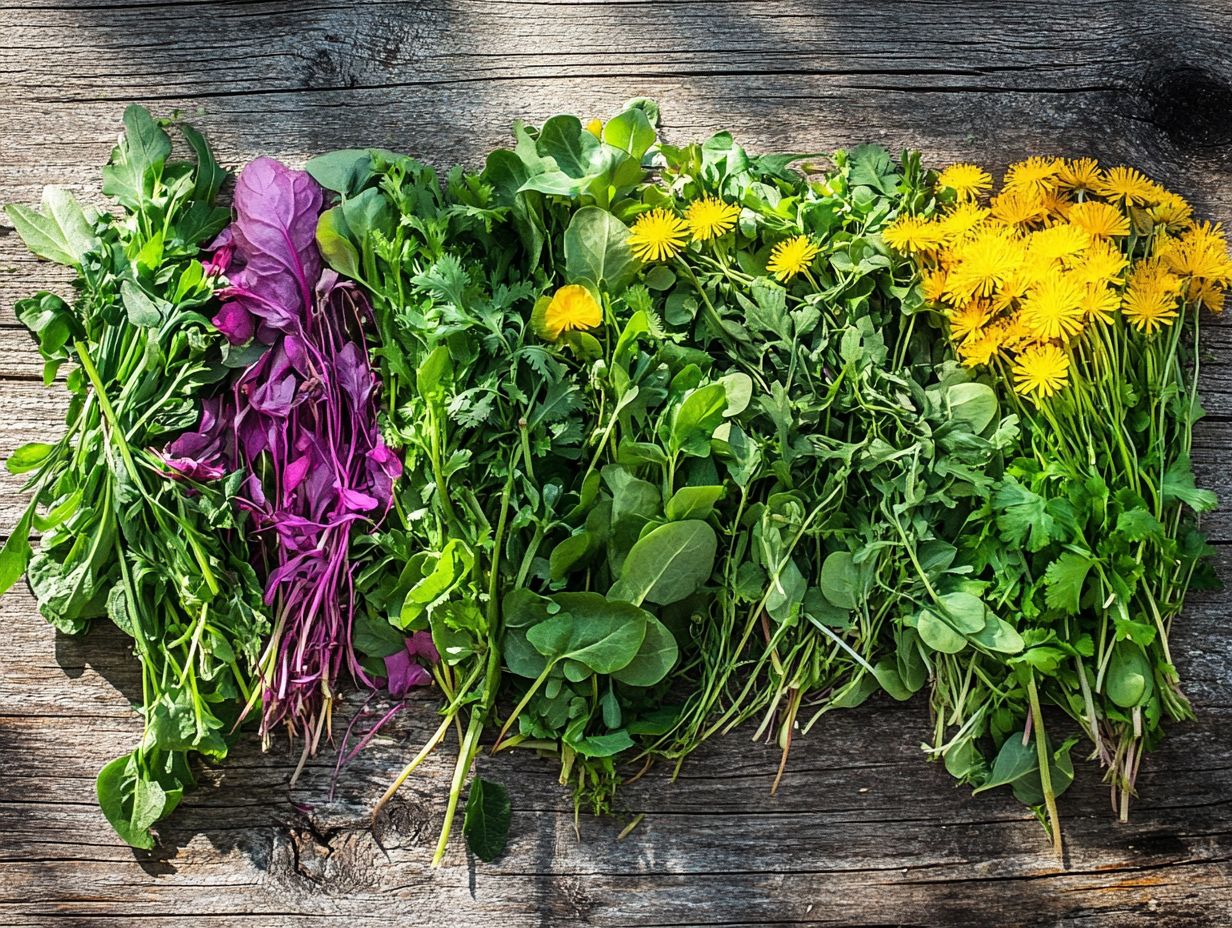
Edible wild greens offer an abundance of preparation and cooking options, allowing you to infuse flexibility into your meal planning and unleash your creativity in the kitchen. Whether you’re tossing them into a vibrant wild salad or incorporating them into infused vinegar for a flavor boost, exploring the most common edible wild greens reveals limitless choices.
Imagine the delightful flavors of fresh salads that showcase their lively taste, or saut ing them with garlic and olive oil to create a warm, inviting side dish that elevates any meal. You might even consider adding them to omelets or frittatas for a nutritious breakfast, or blending them into smoothies for an invigorating energy boost. You ll love discovering new ways to use wild greens!
For those who appreciate a bit of zest, featuring wild greens in pestos can add an earthy flavor that pairs beautifully with pasta or spreads delightfully on sandwiches. The possibilities are truly endless, inviting you to experiment and explore, making wild greens a delightful addition to your culinary repertoire.
What Are the Precautions to Take When Foraging for Edible Wild Greens?
Taking precautions when foraging for edible wild greens is essential for your safety and to avoid potential poisoning or adverse reactions, especially when you’re exploring unfamiliar areas or trying new wild edibles. A solid understanding of local plants and their safe usage is fundamental not only in herbal medicine but also in successful foraging.
Always be aware of your surroundings and steer clear of polluted areas, as contaminants can easily compromise edible resources. Properly identifying plants is another crucial step; many look-alikes can lead to serious health issues if you mistakenly identify them.
Understanding your personal allergies is vital, as some wild greens may provoke unexpected reactions. It’s a good idea to consult reliable resources and guides for in-depth knowledge about different species, their habitats, and how to prepare them safely.
Engaging with local foraging groups can also provide valuable insights and support, enhancing both your safety and enjoyment during the foraging experience. Share your own foraging experiences or recipes using wild greens!
What Are Some Common Misconceptions About Edible Wild Greens?
There are numerous misconceptions about edible wild greens that might be holding you back from embracing these nutritious additions to your diet, including 5 wild edible ingredients you shouldn’t miss.
One prevalent belief is that all wild plants are unsafe or inedible. However, understanding the facts about wild greens can significantly enhance both your foraging skills and your nutritional choices.
It’s common to worry that wild greens could be toxic or unpalatable. The reality is that many of these plants are not only safe to eat but also brimming with essential vitamins and minerals, including the top 7 wild greens to harvest in spring.
The diverse flavor profiles of wild greens can even astonish seasoned chefs. Take dandelion greens, for instance while they have a slight bitterness, they can be absolutely delightful when saut ed or tossed into salads.
By educating yourself on which plants are safe to forage, you can confidently broaden your culinary repertoire and savor the unmatched freshness that comes from fresh, wild ingredients.
How Can Incorporating Edible Wild Greens Benefit the Environment?
Incorporating edible wild greens into your diet can lead to remarkable environmental benefits. For instance, exploring 5 wild plants to forage this winter fosters sustainability and promotes biodiversity by encouraging the preservation of native plant species and ecosystems.
When you forage for these wild greens, you’re not just enhancing your personal nutrition; you’re also contributing to a greater ecological awareness.
For instance, these practices enhance soil health and conserve water, as wild greens often flourish in diverse environments without the need for chemical fertilizers or pesticides.
By embracing foraging, you can actively participate in reducing your carbon footprint and reliance on industrial agriculture, which frequently results in habitat destruction.
Integrating these greens into local diets emphasizes the importance of maintaining healthy ecosystems. These plants provide support for various pollinators and wildlife while enriching the soil.
This interconnectedness highlights the vital role of foraging in cultivating a balanced relationship with nature.
Frequently Asked Questions
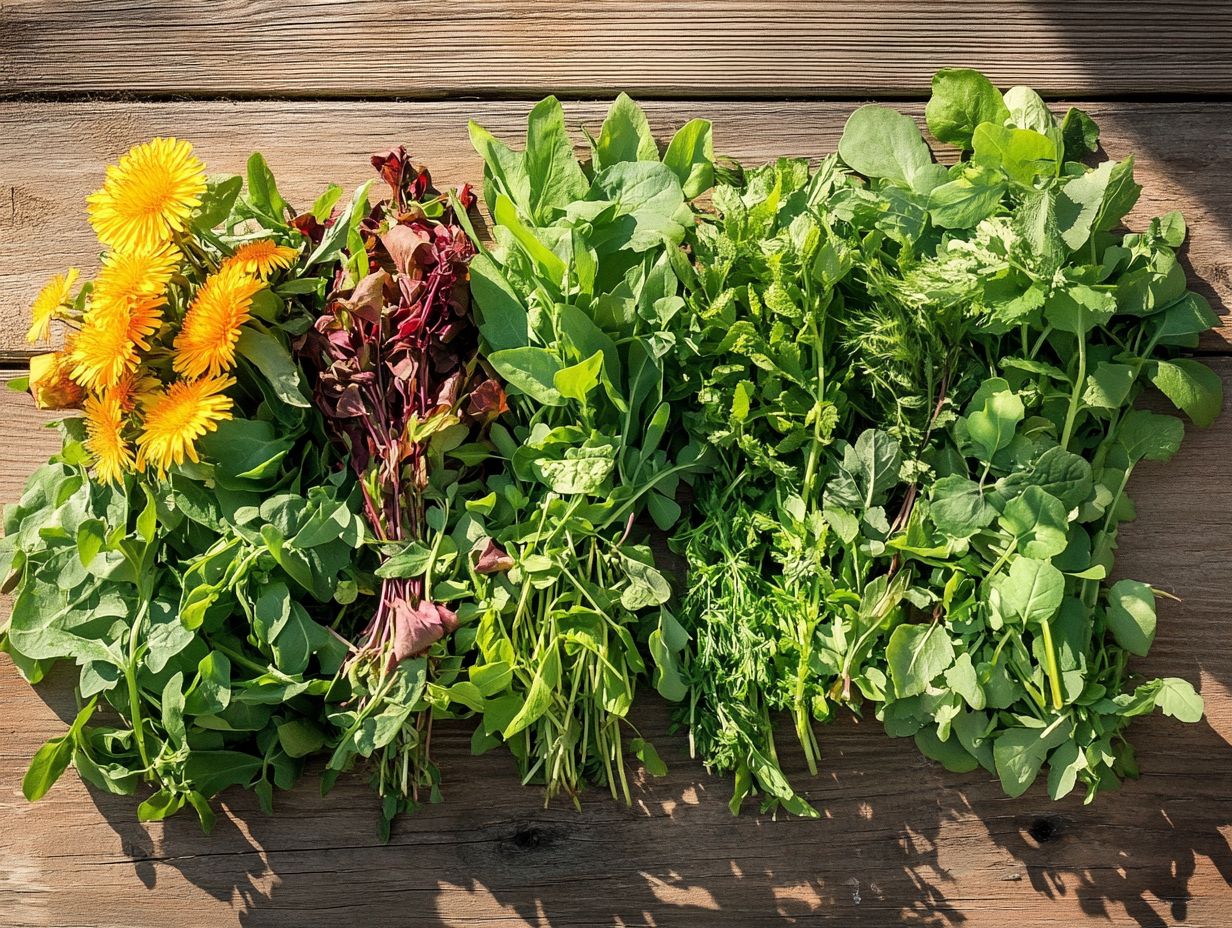
What are the top 5 edible wild greens to look for?
Among the most sought-after are dandelion, chickweed, purslane, wild mustard, and lamb’s quarters, as well as plantago, which can be a nutritious addition. To learn more, check out these essential tips for foraging wild greens.
How can I identify dandelion in the wild?
Dandelion leaves are oblong and tooth-shaped with a distinctive yellow flower and milky white sap. They can often be found in fields, meadows, and lawns.
Can I eat chickweed raw?
Yes! Chickweed can be eaten raw. Its tender leaves have a mild, slightly sweet flavor, making it a great addition to salads or sandwiches.
Where can I find purslane in the wild?
Purslane can be found in sunny, dry areas such as fields, roadsides, and gardens. Look for its succulent leaves and small yellow flowers.
How do I cook wild mustard?
Wild mustard can be saut ed or steamed, similar to other leafy greens. Its spicy flavor pairs well with garlic, lemon, and olive oil, especially when combined with Garlic Mustard for added flavor.
Are lamb’s quarters safe to eat?
Yes, lamb’s quarters are safe to eat. They have a slightly nutty flavor and can be cooked or eaten raw. However, avoid consuming them if they have been growing near roadsides or heavily polluted areas.
Don t miss out on the fresh flavors and health benefits of wild greens start foraging today!

